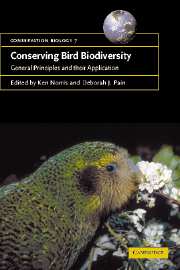Book contents
- Frontmatter
- Contents
- List of contributors
- Preface
- 1 Biodiversity – evolution, species, genes
- 2 Why conserve bird diversity?
- 3 Mapping and monitoring bird populations: their conservation uses
- 4 Priority-setting in species conservation
- 5 Selecting sites for conservation
- 6 Critically endangered bird populations and their management
- 7 Diagnosing causes of population declines and selecting remedial actions
- 8 Outside the reserve: pandemic threats to bird biodiversity
- 9 Predicting the impact of environmental change
- 10 Fragmentation, habitat loss and landscape management
- 11 The interface between research, education and training
- 12 Conservation policies and programmes affecting birds
- References
- Index
10 - Fragmentation, habitat loss and landscape management
Published online by Cambridge University Press: 10 December 2009
- Frontmatter
- Contents
- List of contributors
- Preface
- 1 Biodiversity – evolution, species, genes
- 2 Why conserve bird diversity?
- 3 Mapping and monitoring bird populations: their conservation uses
- 4 Priority-setting in species conservation
- 5 Selecting sites for conservation
- 6 Critically endangered bird populations and their management
- 7 Diagnosing causes of population declines and selecting remedial actions
- 8 Outside the reserve: pandemic threats to bird biodiversity
- 9 Predicting the impact of environmental change
- 10 Fragmentation, habitat loss and landscape management
- 11 The interface between research, education and training
- 12 Conservation policies and programmes affecting birds
- References
- Index
Summary
INTRODUCTION
Fragmentation of natural habitats is a central concern of biodiversity conservation. Indeed, it has been labelled ‘the principal threat to most species in the temperate zone’ (Wilcove et al. 1986) and ‘the single greatest threat to biological diversity’ (Noss 1991). Our central thesis in this chapter, however, is that fragmentation is only one of several ways that human activities can affect the distribution and availability of habitat to organisms. The major conservation issue, in fact, is land use (Meyer & Turner 1994; Dale 1997; Laurance & Bierregaard 1997), and solutions to the threat of fragmentation may be ineffective unless they are placed within a broader framework of changing land use and its impacts on entire landscapes. To develop this thesis, we first consider the physical template of fragmentation and the mechanisms of organism responses. We then address how these points affect our ability to predict the consequences of landscape change, and how this knowledge can contribute to finding solutions to the conservation issues raised by land use and fragmentation.
THE PHYSICAL TEMPLATE
Habitat fragmentation and habitat loss
In its most elementary state, the pattern of fragmentation is unambiguous: bits and pieces of habitat (e.g. forests, grasslands, wetlands) are scattered through a background matrix of non-habitat. This simple ‘habitat/nonhabitat’ conceptualisation of fragmentation has been fostered especially by island biogeography theory (MacArthur & Wilson 1967).
- Type
- Chapter
- Information
- Conserving Bird BiodiversityGeneral Principles and their Application, pp. 202 - 223Publisher: Cambridge University PressPrint publication year: 2002
- 19
- Cited by

